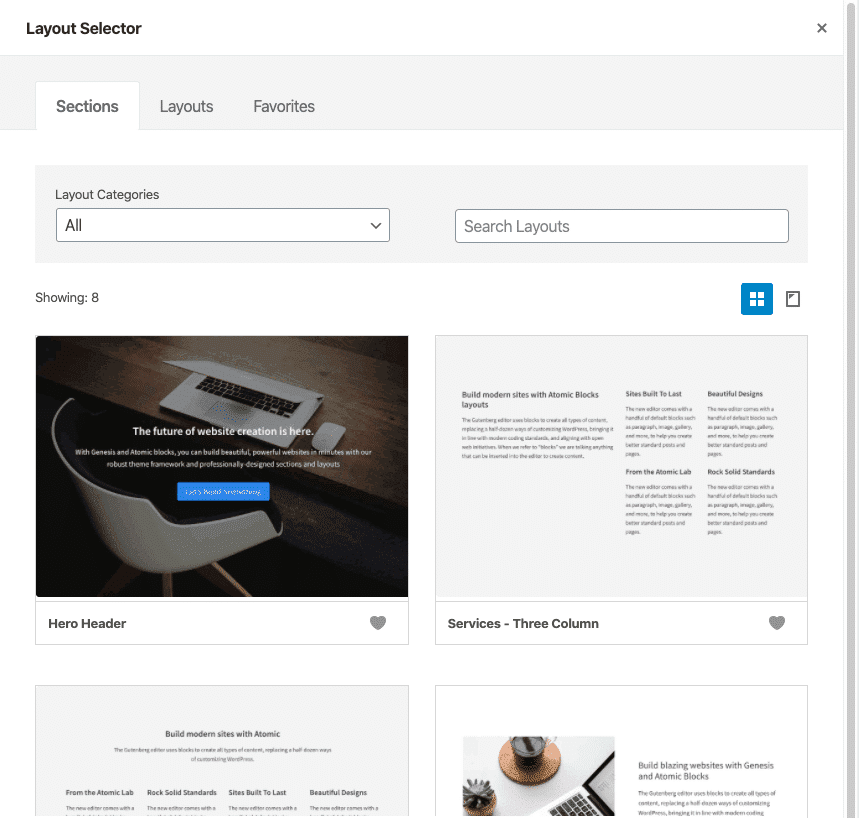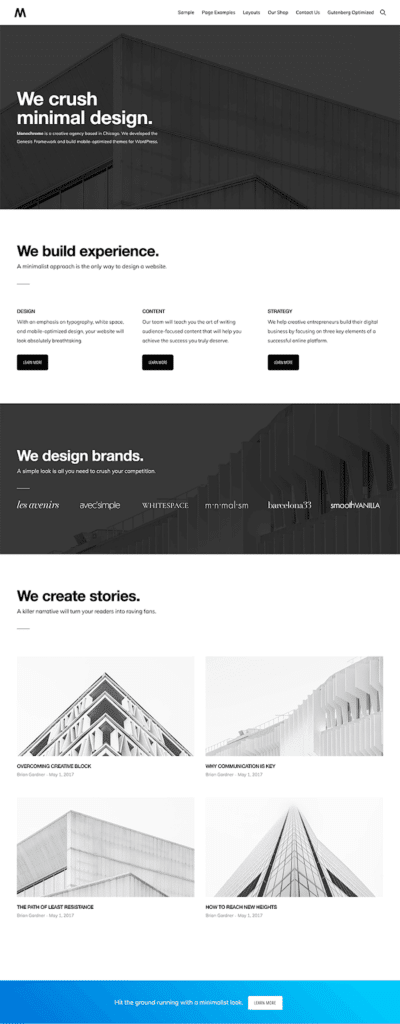Full site editing is coming to WordPress! What exactly is it and what does it mean for you as a Genesis user or developer? Those are the questions we hope to answer for you here. We want to help you stay informed and ahead of the curve with open source Genesis and WordPress.
Full site editing in a nutshell
Full site editing is a complete rethink of building sites with WordPress.
For content creators, it’s an extension of the current block-based editing experience and offers a greater level of control without the need to code.
For theme and plugin developers, it’s a different approach to creating templates, applying base styles, and giving users a head start with block patterns.
For agencies, it’s a way to give powerful content creation abilities to clients while providing “guard rails” to help keep any content changes on brand.
What’s changing?
Traditionally in WordPress, themes, plugins, and the native content editor have played distinct roles. Themes provide the presentation layer, plugins extend the core functionality of WordPress, and the block editor (formerly the Classic Editor) controls post content.
Full site editing changes all of this.
Blocks aren’t limited to the content area; With full site editing, blocks can be used in other places on a WordPress site, such as the header, the footer, or the sidebar.
Themes, as we currently build and use them, must change to embrace the future direction of WordPress.
When is it coming?
The development of full site editing is well underway, but it’s far from a mature product. It’s estimated to be part of WordPress #core by late 2020. Much like Gutenberg, it’s probable that full site editing will be introduced to core before it’s “fully-baked,” meaning that adoption rates will vary based on how you use WordPress and Genesis (more on that later in the article).
The good news is that we’ve been following development since the early days of Gutenberg. We helped prepare you for the changes then and we’re committed to help you through the changes to come so that you can get the most out of WordPress and Genesis.
How it works: A quick history
If you’ve already worked with Gutenberg (a.k.a. the block editor), you’re familiar with the concept of blocks. The block editor was introduced in WordPress 5.0 and, out of the box, worked well with all StudioPress themes.
In WordPress 5.3, the Group block was introduced. This made it possible to nest child blocks within a parent container.
Block patterns take the idea of grouping blocks further and give site users a way to leverage predefined layouts on their sites. This simplifies content creation by giving users a professionally-designed starting point for page layouts. No need to stare at a blank canvas, wondering where to start!
If you’ve used the Atomic Blocks plugin, you’ve already seen this in action. (Not to brag, but Atomic Blocks, which is also part of the WP Engine family, has significantly influenced the development of block patterns in Gutenberg.

How full site editing works with Genesis
As mentioned earlier, Genesis and StudioPress themes already work well with Gutenberg. Our most popular themes have additionally been revamped to take advantage of block-based layouts for the home page.
To date, a block-based theme simply means a theme that includes support for the block editor and includes block styles. Eventually, block-based themes will include support for full site editing, so imagine a world where you can use blocks to lay out the header, footer, sidebar, and other site components.
We’re not quite ready to roll out the specifics of how this works with Genesis, but we’ve hinted at how Genesis is changing to embrace full site editing.
We’re also consulting with our Genesis Shapers (here’s a recap of the April meeting) to get their input on how Genesis can best address the coming changes.
Our R&D team is working alongside the Gutenberg project to ensure that Genesis not only works with full site editing but offers an even better experience for both creating content and developing custom sites.
In short, we’re working hard not only to keep Genesis relevant, but to make Genesis a leading example of how themes can embrace the block editor.
When should you start working with full site editing?
The block editor was introduced to WordPress core in December 2018. Many users pushed back on adopting Gutenberg and continued using the Classic Editor for various reasons, but primarily because the editor felt more like an MVP than a fully-baked feature. Since that time, the block editing experience has improved drastically.
If you (or your clients) still rely on the Classic Editor, now is the time to switch to the block editor since that is the foundation for full site editing. Here’s a great guide you can use to bring you (and your clients) up to speed.
That said, full site editing is still very much in development, so how quickly you engage with it depends on how you use WordPress.
Content Creators
For folks that use WordPress to create content, there’s nothing to really “adopt” at this point. Other than getting familiar with how to use the block editor, there’s nothing else you need to do right now.
Just know that the experience of creating content with WordPress and Genesis will continue to improve in new and exciting ways.
Consultants & Site Creators
This is the right time to fully embrace the block editor for your own sites and for use on new client site builds. The more comfortable you are working with blocks, the more easily you’ll be able to transition to full site editing when the time comes.
For now, make sure you’re using Gutenberg-ready, block-based themes. These are themes built specifically with the block editor in mind. One of the biggest changes you’ll notice is that widgets play a lesser role than ever before. Block-based themes enable you to create visually complex layouts, so instead of hard-coded widget areas in themes (especially on the front page), you use blocks as the foundation of your content design.
The Monochrome Pro theme from StudioPress is a great example of this. Looking at the demo of the home page (or the screenshot below), you’ll see text overlaying images, support for full-width background images, multi-column and grid layouts, etc. Each of these components is a block, some native to WordPress and some blocks provided by the free plugin Atomic Blocks.

Creating layouts with blocks instead of widgets gives you greater flexibility when it comes to delivering beautifully-designed layouts for clients. And, of course, many customizations can be made without needing to touch the code, which speeds up site creation workflow.
If you haven’t started working with block-based themes that are currently available, download one of these StudioPress themes* and start experimenting. Once you feel comfortable working with block-based content layouts, you’ll be ready to embrace full site editing when it’s officially rolled into WordPress.
* all StudioPress theme packages are free for WP Engine customers
Theme & plugin developers
The time to dig into full site editing is now!
It’s worth repeating that these are experimental features and not intended for use on production sites. However, as you make plans for future plugin or theme development that leverages blocks, you’ll want to be familiar with WordPress developments in full site editing.
To keep track of the Gutenberg project in Github, here are two great “summary” tickets:
In addition to those overviews, here is related developer documentation:
- Blocks API
- Block-based Themes (experimental)
- Block Patterns API (experimental)
As for Genesis, the engineering team has been focused on an experimental plugin version of Genesis code-named “Genesis X” which will be freely available once released. If you’re not already subscribed to the StudioPress blog, there’s a signup at the end of this article. You’ll receive the latest news on Genesis as it becomes available.
You can also keep an eye on the Genesis Sample Theme as an example of how to currently build a block-based theme with Genesis Framework.
In Summary
There are a lot of changes coming to WordPress in the not-too-distant future. We’re here to help you prepare for those changes so that you can continue to build better WordPress sites faster with Genesis.
